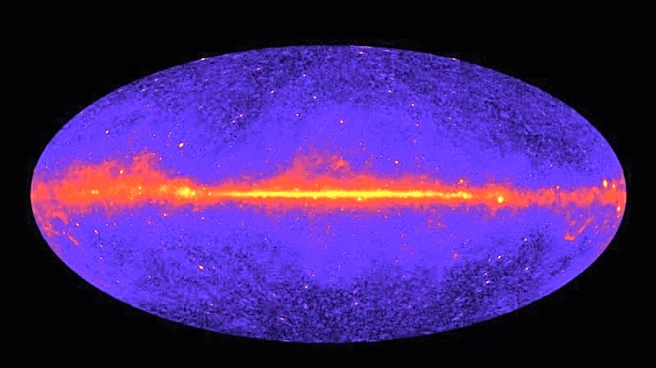What's Happening?
Scientists at the University of York have proposed a new theory suggesting that dark matter, which constitutes over 80% of the universe's matter, might indirectly affect the color of light passing through regions rich in dark matter. The study posits
that light could acquire a faint red or blue tint depending on the type of dark matter it encounters. This interaction is theorized to occur through intermediate particles like the Higgs boson, despite dark matter not interacting directly with light. The findings indicate that if dark matter consists of Weakly Interacting Massive Particles (WIMPs), light passing through such regions would lose high-energy blue photons, resulting in a red tint. Conversely, if dark matter interacts only through gravity, the light would shift to a faint blue hue.
Why It's Important?
This theory could significantly impact the field of cosmology by providing a new method to study dark matter, which has been elusive due to its non-interaction with light. Detecting these subtle color shifts in light could help differentiate between various dark matter models, potentially narrowing down the search for dark matter particles. The implications extend to future astronomical observations, as next-generation telescopes with enhanced sensitivity might be able to detect these color shifts, offering a new observational window into the universe's dark matter composition.
What's Next?
Future observatories, such as the European Extremely Large Telescope and NASA's Nancy Grace Roman Space Telescope, could test these predictions by measuring the light spectrum of distant objects. If successful, this approach could refine the search for dark matter and guide the development of experiments aimed at detecting dark matter particles. The study encourages a focus on regions of space where these color shifts might be most pronounced, potentially saving time and resources in the ongoing quest to understand dark matter.
Beyond the Headlines
The study introduces a novel perspective on dark matter's interaction with light, challenging the conventional view that dark matter is entirely 'dark.' This could lead to a paradigm shift in how scientists approach the study of dark matter, emphasizing indirect interactions and their observable effects. The research also highlights the importance of interdisciplinary approaches, combining particle physics and cosmology to unravel complex cosmic phenomena.














